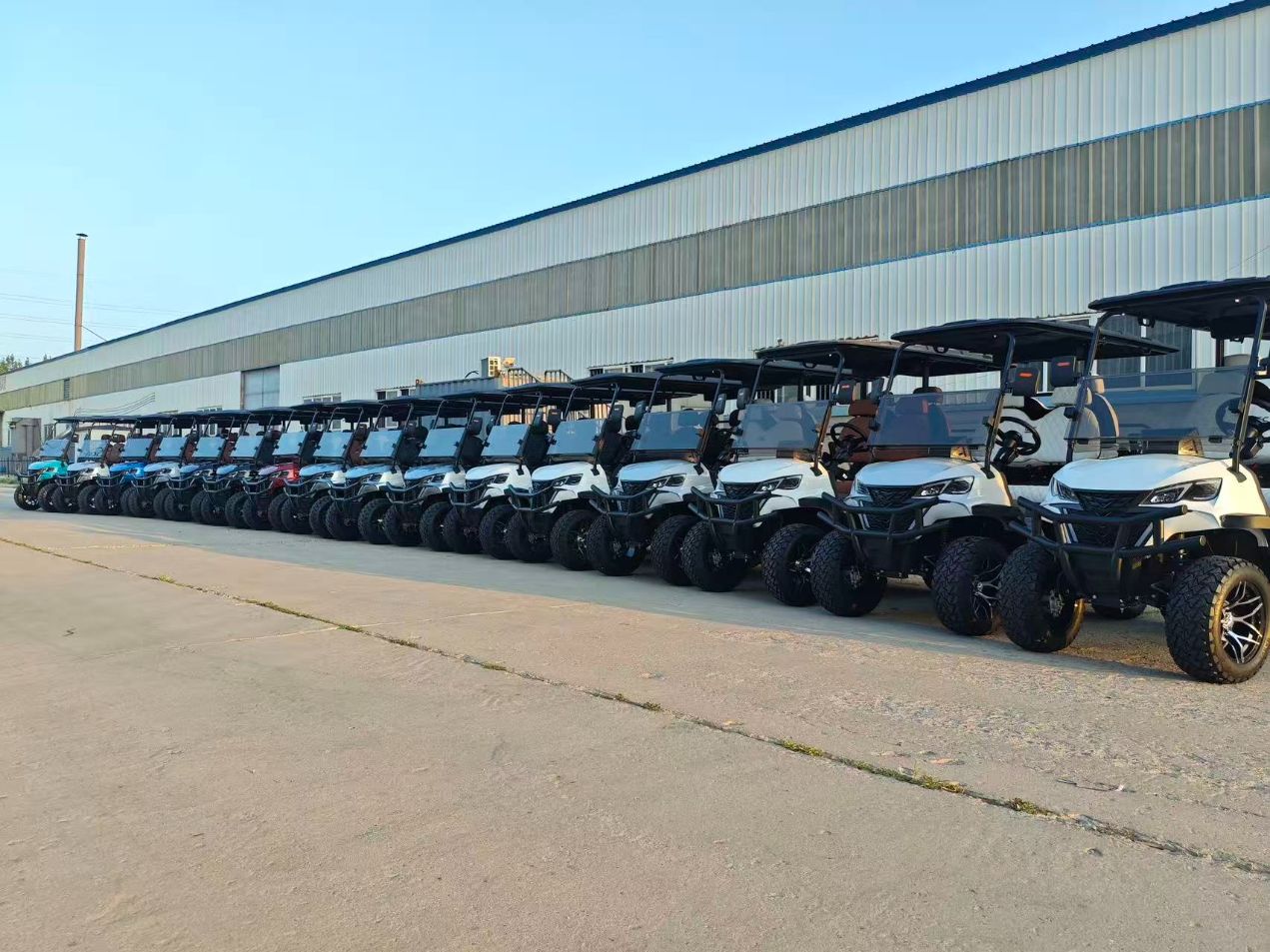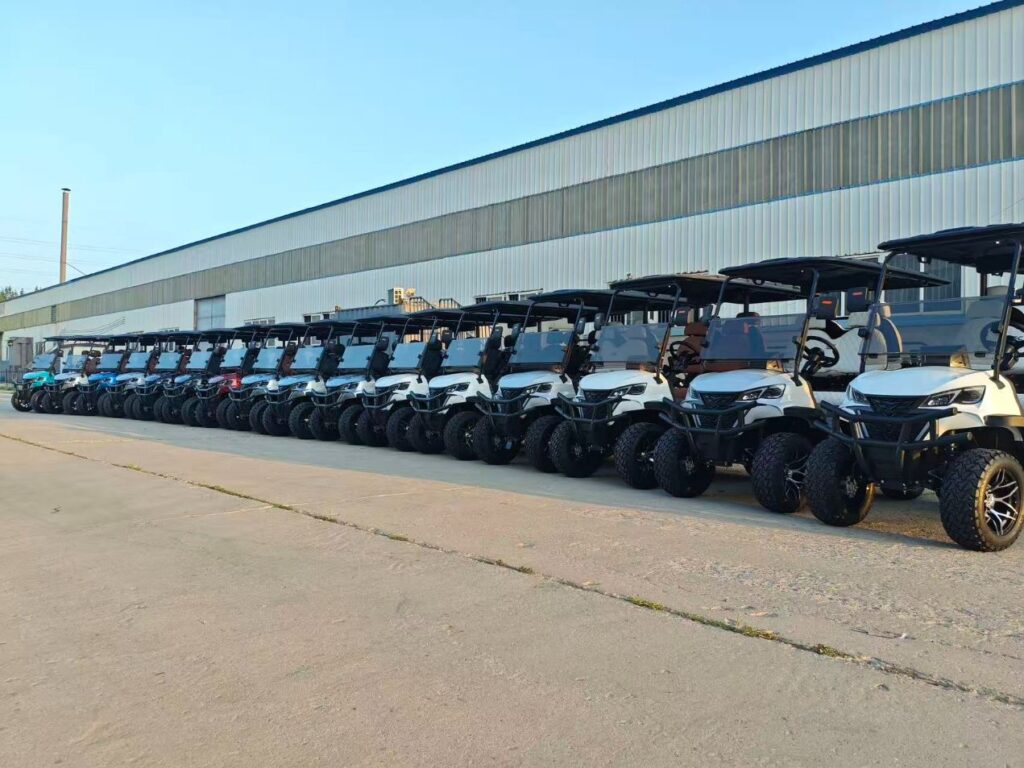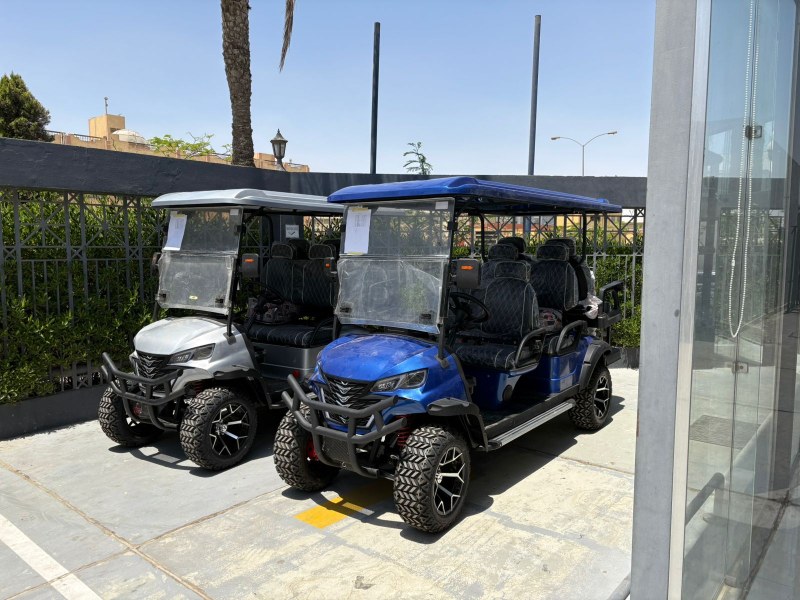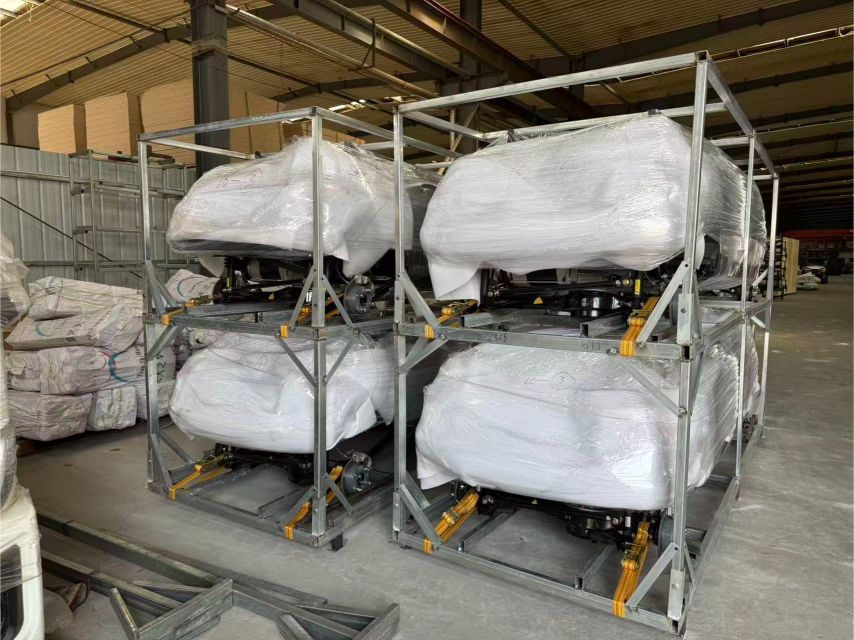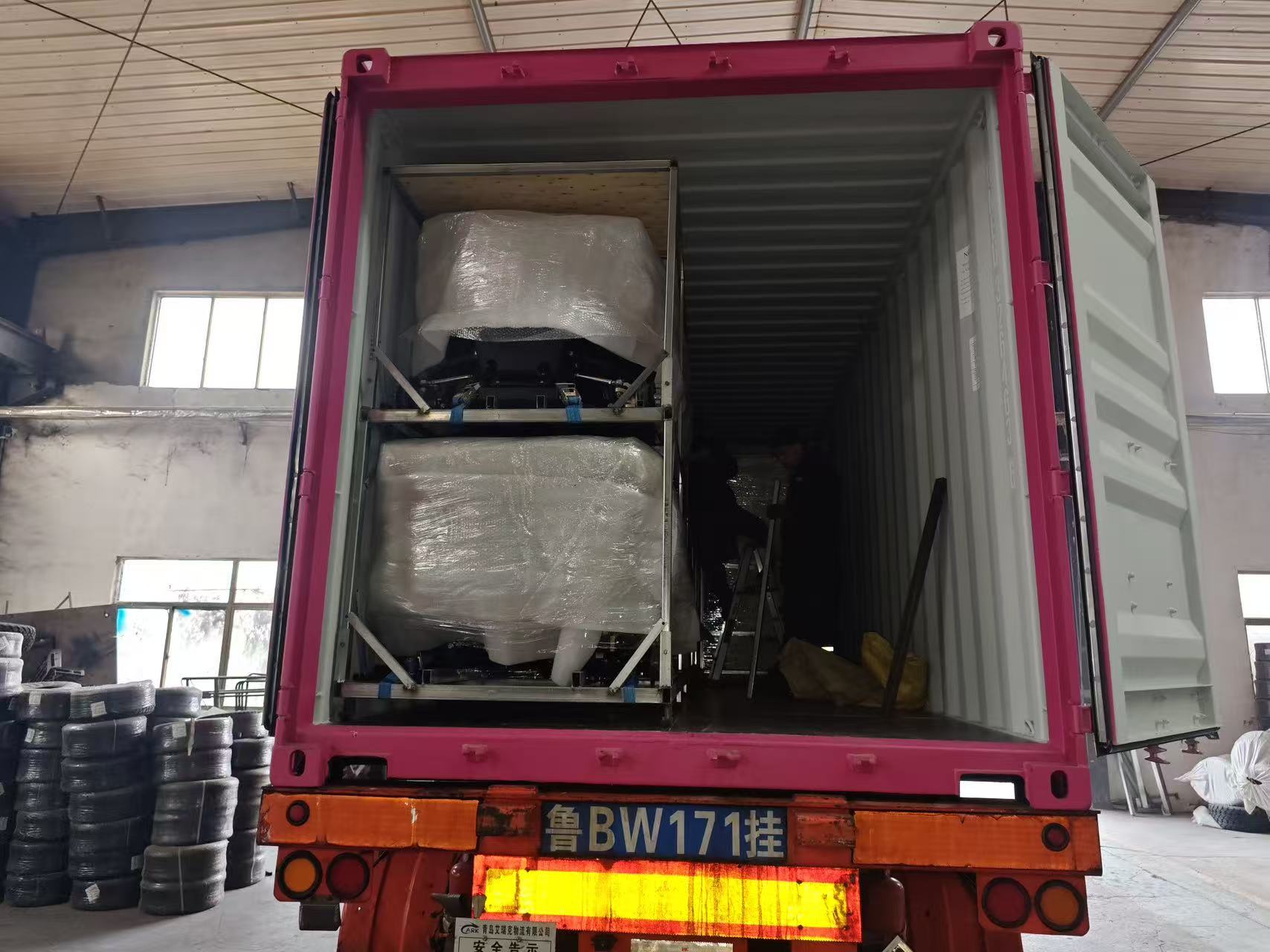If you are planning to purchase a golf cart—whether for a golf course, resort, community shuttle, or personal use—the first question that likely comes to mind is: “How much does a new golf cart cost?”
In general, the ex-factory prices of new electric golf carts made in China are as follows (battery not included):
• 2-seater model: around US$2,800 – 3,800
• 4-seater model: around US$3,200 – 4,200
• 6-seater model: around US$42,00 – 5,200
It’s important to note that these prices refer to the “bare vehicle price” (Ex-Factory Price) — excluding the cost of batteries, motor upgrades, shipping, and taxes. If you choose lithium batteries, imported components, or advanced suspension systems, the total price will increase accordingly.
In fact, there is no fixed standard for golf cart pricing, as it depends on multiple factors. In this article, we will analyze the main elements that affect the overall cost from the perspective of a professional manufacturer, including:
By the end of this guide, you’ll understand the price differences among various configurations, enabling you to choose a golf cart that suits both your budget and practical needs.
- Number of seats and vehicle structure
- Battery type and capacity
- Motor power and control system
- Suspension, braking, and chassis configuration
- Body materials and customization options
- Certifications, transportation, and after-sales service
1. Number of Seats Determines Usage and Price
The most fundamental price difference in golf carts usually comes from the number of seats and the body structure. Different applications require different seat configurations:
• 2-seater golf carts – Commonly used on golf courses or for personal use. They are compact, flexible, and ideal for individual mobility.
• 4-seater golf carts – Perfect for family outings or resort transportation. They strike a good balance between comfort and space, making them one of the most popular configurations.
• 6-seater, 8-seater, or larger carts – Typically used in large resorts, hotels, communities, or sightseeing areas. These models feature longer bodies, higher passenger capacity, and greater manufacturing costs.
• 2-seater or 4-seater utility golf carts – Equipped with a cargo box or flatbed, these versatile models are suitable for farms, warehouses, factories, or maintenance operations, serving both passenger and cargo purposes.
In general, the more seats and the larger the vehicle, the more materials and components are required, which naturally increases the overall cost and selling price.
2. Battery Type and Voltage Configuration
The battery is one of the most crucial factors affecting the price of a golf cart. Different battery types and voltage systems directly determine the vehicle’s cost, performance, and user experience.
Before purchasing, you should first consider two key questions:
• Will you choose a Lithium Battery or a Lead-acid Battery?
• Will your system run on 48V or 72V?
| Battery Type | Main Features | Warranty | Cost Difference |
| Lead-acid Battery | Lower cost, requires regular maintenance and water refilling, heavier weight | About 1 year | Cheaper |
| Lithium Battery | Longer lifespan, faster charging, maintenance-free, lightweight | About 5 years | More expensive (around USD 800–1200 higher) |
Additionally, voltage configuration also plays a major role:
• 48V system: Common for standard models; offers good value for money.
• 72V system: Provides stronger power and better climbing performance — ideal for hilly resorts or communities — but comes with a slightly higher price.
In general, a golf cart equipped with a 72V lithium battery can cost 20%–30% more than a 48V lead-acid version.
Although the initial investment is higher, lithium batteries last longer and require minimal maintenance, making them more economical in the long run.
3. Motor Power: Determines Performance and Cost
Motor power is one of the key parameters that define a golf cart’s performance. It directly affects acceleration, climbing ability, and top speed.
Currently, the mainstream motor power configurations are as follows:
• 3.5KW / 4KW — Standard configuration, ideal for flat terrains or regular golf courses.
• 5KW — High-performance setup with stronger power output, suitable for resorts or light slopes.
• 7.5KW — Professional-grade configuration, designed for mountainous areas, steep terrains, or heavy passenger loads.
The higher the power, the better the vehicle’s performance — and the higher the cost.
For example, a 7.5KW two-seater golf cart typically costs about USD 500–800 more than a 3.5KW standard version.
In addition, motor performance is closely paired with the controller system. High-end models are usually equipped with Curtis (USA brand) or Toyota technology controllers, which provide smoother acceleration, more responsive braking, and enhanced safety — though they also slightly increase the total vehicle cost.
4. Suspension and Brake Systems
The suspension and brake systems are critical components that determine a golf cart’s driving comfort and safety. Different structural designs have a clear impact on the vehicle’s stability, handling, and overall cost.
🧩 Suspension System
• Leaf Spring Suspension – Simple, durable, and low-cost design; ideal for flat terrains and standard golf courses.
• MacPherson Independent Suspension – Effectively absorbs bumps and enhances ride comfort; commonly used in mid-to-high-end models.
• Double Wishbone Suspension – A premium configuration featuring superior shock absorption and driving stability; delivers a car-like driving experience.
⚙️ Brake System
• Mechanical Drum Brake (Standard Brake) – Common in economy models, easy to maintain, with moderate braking force.
• Electromagnetic Brake – More responsive and capable of automatically holding the cart in place on slopes, offering better safety performance.
Upgrading to advanced suspension or electromagnetic brake systems can increase the vehicle cost by around USD 300–800, but it significantly improves ride quality, handling, and safety.
For resorts, hilly areas, or upscale residential communities, this is a highly worthwhile investment.
5. Order Quantity
In international trade, the sample price (Single Unit Price) is usually higher than the bulk order price.
This is because when the order quantity is small, fixed costs such as transportation, packaging, and labor cannot be efficiently distributed, leading to a higher average cost per unit.
For example:
• Single sample unit (1 cart): around USD 5,500
• Bulk order (10 carts): unit price can drop to around USD 4,900
As you can see, the larger the order quantity, the lower the unit cost becomes.
Therefore, if your budget allows, it is recommended to place a bulk order.
Not only does this provide better cost efficiency, but it also ensures priority in packaging, shipping, and after-sales support.
6. Trade Terms (Incoterms)
The final price of a golf cart doesn’t depend solely on its configuration — it is also closely related to the international trade terms (Incoterms) agreed between buyer and seller. Different trade terms determine who is responsible for shipping, insurance, and export/import procedures.
Common Incoterms include:
• EXW (Ex Works) — Factory price: The buyer picks up the goods from the manufacturer’s factory and is responsible for export clearance, shipping, and insurance.
• FOB (Free On Board) — Port-to-port price: The seller delivers the goods to the designated port in China and handles export customs clearance; the buyer covers ocean freight and costs after arrival.
• CIF (Cost, Insurance & Freight) — Delivered to port price: The seller handles shipping and insurance to the buyer’s destination port.
The same golf cart can vary by USD 500–1000 between EXW and CIF, depending on shipping routes, destination port, and current freight rates.
If you’re importing for the first time, it’s recommended to choose CIF or FOB, as the manufacturer will assist with export and shipping, making the process smoother. Experienced importers, however, may prefer EXW, allowing them to manage logistics and costs directly.
7. Summary: How to Estimate Your Budget Range
After analyzing all key factors, you should now have a clear understanding of what influences a golf cart’s price — from seat configuration and battery type to motor power, suspension system, and trade terms.
Here’s a quick reference price guide to help you identify your ideal price range 👇
| Configuration Type | Estimated Price Range (USD) |
| 2-seater golf cart | $3,500 – $4,500 |
| 4-seater golf cart | $4,800 – $6,000 |
| 6-seater golf cart | $6,000 – $7,500 |
• Choosing lithium batteries + high-power motor + double wishbone suspension will place your price toward the upper end of the range.
• Standard setups with lead-acid batteries and basic features will be near the lower end.
• Bulk orders and CIF terms typically offer better cost efficiency and more reliable shipping service.
Professional Advice: How to Communicate Efficiently with Manufacturers
If this is your first time purchasing golf carts, follow these practical steps:
• ✅ Define your purpose and budget — for example, whether the cart will be used in golf courses, resorts, communities, or for personal mobility.
• ⚙️ Discuss configuration details — including seat number, battery type, motor power, suspension, and brake systems.
• 🎨 Confirm customization needs — such as adding your logo, mixed body colors, or branded components (e.g., Curtis controller, KDS motor).
• 📋 Request a detailed Specification & Quotation Sheet — ensuring all parameters are clear and transparent.
By doing so, you can avoid unnecessary costs and get the most suitable configuration for your needs.
🌟 Want to learn more?
Contact Ancient Star — China’s expert manufacturer of high-quality electric golf carts.
📞 WhatsApp: +86 182 9243 8981 🌐 Website: www.chinaevvehicle.com
✉️ Email: info@asevvehicle.com

